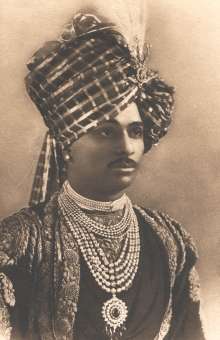Lakhajirajsinhji II Bavajirajsinhji
 | |||||||||||||||||||||||||||
| Personal information | |||||||||||||||||||||||||||
|---|---|---|---|---|---|---|---|---|---|---|---|---|---|---|---|---|---|---|---|---|---|---|---|---|---|---|---|
| Full name | Lakhajirajsinhji | ||||||||||||||||||||||||||
| Born |
17 December 1885 Rajkot, British India | ||||||||||||||||||||||||||
| Died |
2 February 1930 Rajkot, British India | ||||||||||||||||||||||||||
| Batting style | Right-handed | ||||||||||||||||||||||||||
| Bowling style | Right-arm fast | ||||||||||||||||||||||||||
| Relations |
Ranjitsinhji (uncle), Pradyumansinhji (son), Manoharsinhji (grandson) | ||||||||||||||||||||||||||
| Career statistics | |||||||||||||||||||||||||||
| |||||||||||||||||||||||||||
| Source: CricketArchive, 12 December 2012 | |||||||||||||||||||||||||||
Lakhajirajsinhji II Bavajirajsinhji (17 December 1885 – 2 February 1930), the 12th Thakore Saheb of Rajkot, was an Indian nobleman, who was ruler of the princely state of Rajkot from April 1890 until his death. The oldest son of Bavajirajsinhji Mehramanji, the 11th Thakore Saheb of Rajkot, Lakhajirajsinhji acceded to the title at the age of four, after his father's death.[1] The nephew of Ranji, Lakhajirajsinhji was a keen cricket enthusiast, and was a patron of the game in British India. He visited England several times, and during a 1908 visit played a game for the Gentlemen of England against Oxford University, which was accorded first-class status.[2] In an attempt to anglicise his name, the Wisden Cricketers' Almanack mistakenly recorded him as "Prince Chakorsab".[3] Lakhajirajsinhji would play two further first-class matches: one in 1912, for Hindus in the Bombay Quadrangular, and one in 1922, captaining a combined Hindus and Muslims side against a combined Europeans and Parsees side.[4] The latter match was his most successful, and included the first three wickets of his opponents' first innings, on the way to career-best figures of 3/77.[5]
Similar to his father, Lakhajirajsinhji was considered a progressive ruler, which was encouraged by the British administration of the time.[1] Having reigned under British guardianship until October 1907, when he was considered able to rule independently, he was in attendance at the Delhi Durbar in 1911, which marked the coronation of George V, Emperor of India, and was made a Knight Commander of the Order of the Indian Empire in June 1918.[6] Encouraging the development of public debate and intellectualism within Rajkot, Lakhajirasinhji established a State Council and State Bank in 1910, as well as a Peoples' Assembly in 1923.[7] He died at the Ranjit Villas Palace in February 1930, and was succeeded firstly by his oldest son, Dharmendrasinhji (1910–1940), and then by his third son, Pradyumansinhji.[1] Both Pradyumansinhji and his son, Manoharsinhji, also played first-class cricket.[3]
Titles
- 17 December 1885 – 16 April 1890: Kumar Lakhajirajsinhji, Yuvraj Saheb of Rajkot
- 16 April 1890 – 3 June 1918: His Highness Thakore Saheb Lakhajirajsinhji II Bavajirajsinhji, 12th Thakore Saheb of Rajkot
- 3 June 1918 – 2 February 1930: His Highness Thakore Saheb Sir Lakhajirajsinhji II Bavajirajsinhji, 12th Thakore Saheb of Rajkot, KCIE
Further reading
- Brahmbhatt, Rajendra Harilal (1990). Aspects of the life and works of Sir Lakhajiraj of Rajkot State under British paramount power (M.A. thesis). San Jose State University.
References
- 1 2 3 Rajkot (Princely State) – Indian Rajputs. Retrieved 12 December 2012.
- ↑ Oxford University v Gentlemen of England, University Match 1908 – CricketArchive. Retrieved 12 December 2012.
- 1 2 Thakore Saheb of Rajkot – CricketArchive. Retrieved 12 December 2012.
- ↑ First-Class Matches played by Thakore Saheb of Rajkot (3) – CricketArchive. Retrieved 12 December 2012.
- ↑ Europeans and Parsees v Hindus and Muslims, Other First-Class matches in India 1922/23 – CricketArchive. Retrieved 12 December 2012.
- ↑ The London Gazette: (Supplement) no. 30723. p. 6531. 3 June 1918.
- ↑ RAJKOT 3 – Royal Ark. Retrieved 12 December 2012.
| Regnal titles | ||
|---|---|---|
| Preceded by Bavajirajsinhji |
12th Thakore Saheb of Rajkot 1890–1930 |
Succeeded by Dharmendrasinhji |